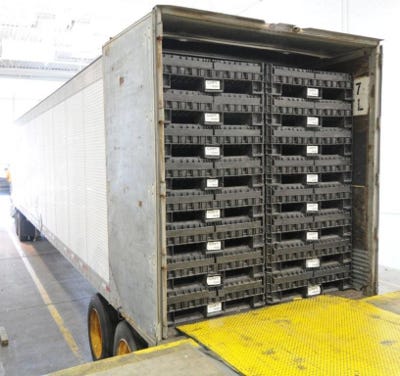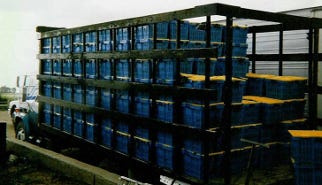Using reusables to their max 39476
January 29, 2014
Many companies are reaping the financial and environmental benefits of using reusable packaging. But every supply chain is different, so companies must identify and measure their unique factors to determine whether reusables are the right solution. Today's decisions must consider all of the impacted stakeholders and variables in the supply chain to identify "best fit" packaging. In some cases, one-way packaging might be the best solution. In others, a combination of reusables and single-trip packaging makes the most sense.

Folded down reusable container
What are "reusables"? We define reusable packaging as pallets, containers and dunnage used to store, handle and move products throughout a supply chain—and then be reused repeatedly for its original purpose.
The Reusable Packaging Assn. (RPA) has a free online tool, the Quick Calculator (http://reusables.org/library/calculators), that helps companies do an initial assessment by comparing basic cost differences of one-way corrugated packaging versus reusable plastic packaging. This shows that the old paradigm of lowest procurement cost does not always capture the true lowest economic cost of packaging. But before presenting the idea of reusables to management, it's helpful to have some understanding of their potential financial impact.
Adding up the financial impact
Using reusable packaging can impact any or all of a company's major financial categories: It can enhance revenue, optimize capital utilization and reduce operating expenses.
• Enhance revenue: Reusables can enhance revenue in two areas. One is at the store level, where retail-ready reusable packaging allows product manufacturers to place more product within the same shelf space to minimize stockouts and, therefore, possibly increase sales. Or a company could choose to add a second SKU within the same space, resulting in accelerated sales.
The second area is at the plant level. Many brick-and-mortar plants and distribution networks are straining under increasing SKU proliferation. With standardized designs and automation friendly features, reusable packaging can optimize plant or warehouse space and move product throug the supply chain faster and more accurately, with little to no system downtime.
• Optimize capital utilization: Making an outright purchase of reusables requires capital. If capital is limited, a company could rent or lease the packaging, keeping its capital free to invest in other strategic initiatives. If a company is looking strictly at per-unit procurement cost, expendables are less expensive than reusables, but they won't provide a long service life and will require frequent, recurring expenses.

Reusable containers efficient shipping
• Reduce operating expenses: Reusables can have the greatest financial impact in reducing operating expenses. The most common operating expenses impacted by reusables are:
1. Total procurement costs: This equates to the cost of purchasing or leasing reusables. Although this will be a significant line item, it's important to remember to take a holistic look at the impact of reusables. If reusables are a good fit, other expenses will decrease, lowering the item cost over the long term.
2. Product damage: A well-designed reusable pallet, tote or container can protect contents and reduce damage. If a company is shipping an expensive product, the benefits of placing it in a sturdy yet relatively inexpensive reusable container can be significant. Saving even a little bit on product damage each turn can add up.
This area is especially significant for perishable goods. Reusable produce containers offer improved ventilation that removes field heat faster and reduces product spoilage. Tosca helped bring this benefit to the spinach industry as it moves product from the field to processor. Reusable containers have helped reduce spoilage as well as improve product safety.
3. Downtime: At some businesses, downtime and inefficient operations can cost thousands of dollars per minute. PBR Columbia South Carolina LLC, a leading brake manufacturer supplying major automotive corporations, hauled large amounts of materials from staging areas to line operations on the plant floor. The company was actually spending more time hauling the containers housing the brake components rather than moving the actual components themselves. To address this issue, PBR purchased a customizable, collapsible bulk container from Buckhorn. The end results were a cleaner workspace with the removal of more than 100 outdated conveyers, a reduction of required storage areas, improved workflow with batch sizes cut in half, fewer injuries, less waste and better product quality.
4. Disposal costs: Eliminating disposal costs for expandable products is an obvious gain. Companies that don't have local systems in place for recycling, or don't have the ability to collect used packaging, might be paying substantial fees to dispose of expendable packaging.
For example, Ghirardelli Chocolate Co. had been spending $520,000 annually on 580,000 fiberboard boxes for internal distribution. The boxes would get soiled and thrown in the trash, racking up an additional $2,700 in disposal costs. Switching to reusable totes has resulted in a net packaging reduction savings of $1.95 million over five years and prevented 350 tons of soiled board from going into the landfill.
5. Dunnage: Cushioning is necessary for product protection, but dunnage often ends up in the landfill after a product arrives at its destination. Some reusable containers are sturdy enough to eliminate the need for dunnage. At other times, the dunnage itself is reusable.
For years, Lyons Magnus, a shipper of cased goods, looked for a less expensive way to protect its heavy freight. The company was using several 4-in. corrugated panels in the nose of trailers for spacing, and then loading the product up against them. Lyons Magnus found that they could reuse the panels two to three times before they were crushed, and then had to be disposed of in solid waste landfills. Then Lyons Magnus began using Paylode reusable plastic dunnage. The interlocking units withstand up to 20,000 lbs of force without crushing, and they are reusable.
6. Labor: Many companies want labor taken out of the systems and moved upstream—and reusables can help accomplish this.
Companies can automate packaging by putting consumer goods directly into retail-ready reusable containers right at the manufacturing site. Other companies hire third-party poolers to repack to reduce store labor. Food Maxx, a wholesale grocery outlet in California's Alameda County, reports that displaying carrots in reusable produce containers saves time compared to unloading and stacking bags of carrots by hand.
John Deere passive RFID tags on bulk containers
7. Packaging materials: Although buying reusable packaging can require a significant capital investment, it can reduce the overall cost of packaging material in the long run. John Deere estimates that they are saving about 85 percent in packaging. For example, instead of transporting lighting brackets within its supply chain in two heavy duty 24x24x36-in. boxes ($21 each) on an $8 wood pallet, the material can be packed in a 45x48x34-in. reusable container that costs less than $20 to cycle. John Deere uses reusables in about 95 percent of its worldwide operations.
8. Transportation costs: With increasing fuel costs, companies are seeking to maximize the amount of product they ship, and the standardized design and efficient footprint commonly found with reusable packaging offers companies better ways to optimize 53-ft trailers for outbound and inbound shipments.
Common challenges
To be fair, there are some challenges in using reusables for an assembly plant, distribution center or warehouse. Key considerations include:
• Reverse logistics costs.
• Risk of significant potential for loss or theft.
• Supply chain collaboration. Reusable packaging programs can strain trading partner relationships if one partner is not executing the program efficiently, adding cost.
• Seasonality. Reusable packaging may not make sense if there are significant seasonality swings that require a large float of assets or if product lines switch frequently and the payback period is too short.
• Marketing or branding requirements.
• Existing equipment requirements. Reusable packaging may not make sense if it does not interact well with existing equipment.
• Supply chain control. Are there closed shipping loops to ensure reusable packaging can be efficiently returned for reuse?

Tosca reusable produce packs
Many factors come into play when implementing a reusable program that you don't see when using expendable packaging. Should you buy, rent or lease? Do you need outside services like pooling or container washing? Most importantly, do you have adequate operational controls for outbound, as well as reverse supply-chain logistics?
For example, reusables require transportation and labor to get them back to the original point to be used again. This requires new systems to get the asset into the right truck, to the right place and moving again within a distribution network.
As companies invest capital to build new facilities or install new automation, it's important to consider how packaging will interface with the equipment. A good "best practice" is to consider reusable totes and pallets early in the planning process, so the system will perform seamlessly when complete. Often, decisions about the type of transport packaging are not considered until the product is ready for production. At that point, marketing, operational and trading partner considerations might limit packaging choices. For example, a company wanted to eliminate expendable boxes, but the new multi-million dollar production and high-speed case erectors already in place would not work well with reusable packaging. In that case, reusable packaging would have caused downtime.
Lastly, a major cost driver of reusables is shrinkage. Systems can help you track your assets, but operational controls are the best way to help reduce shrink. Misplacing a corrugated box is not a significant loss. However, losing $25 totes will become costly over time. So you need to consider whether you can build adequate operational controls into your supply chain.
Although creating the infrastructure to support reusables requires time and effort, it has been the experience of many users that the returns well outweigh the exertion.

Jerry Welcome
Author Jerry Welcome, president of the Reusable Packaging Assn., developed this article based in part on content presented by Lane Pence, director, growth strategy, CHEP USA, at the RPA workshop at PACK EXPO 2010.
Buckhorn Inc., 800-543-4454. www.buckhorninc.com
Container and Pooling Solutions (CAPS), 888-873-2277. www.usecaps.com
CHEP USA, 407-370-2437. www.chep.com
IFCO, 877-430-4326. www.ifco-us.com
Paylode, 877-421-2914. www.paylode.com
Reusable Packaging Assn., 703-224-8284. www.choosereusables.org
REUSABLES 101 (102, 103 and 104)
The Reusable Packaging Assn. is developing a four-part curriculum that will explain in depth the challenges and processes of implementing a reusable program. The curriculum for the first stage, called "Concept Understanding," will be available at PACK EXPO Las Vegas. In this phase, end users are in an investigative mode seeking basic information on reusable packaging to help them better understand the products and services provided by the reusable packaging industry.
Once they have made this decision to implement a reusable solution, they move into phase two which we call "Concept Acceptance." In this phase, users will learn the importance of "Internal Stakeholder Alignment," the process of making sure that everyone in the supply chain understands how this change will impact their function. From management to the shipping dock, a reusable solution must have strong alignment through all core function areas to be successful.
After securing alignment, users are guided through the process of answering a number of important questions, including which is the right type of reusable product or service for their particular operation, how they will finance the assets and whether they should outsource logistics, packaging and/or container management. The content for this second phase will be delivered at PACK EXPO Las Vegas this fall.
After a company has completed the first two phases, they can move on to phase three, "Concept Implementation," and then phase four, "Concept Refinement." The entire curriculum will be available at the end of 2012 as a series of classes from the RPA.
.
About the Author(s)
You May Also Like


